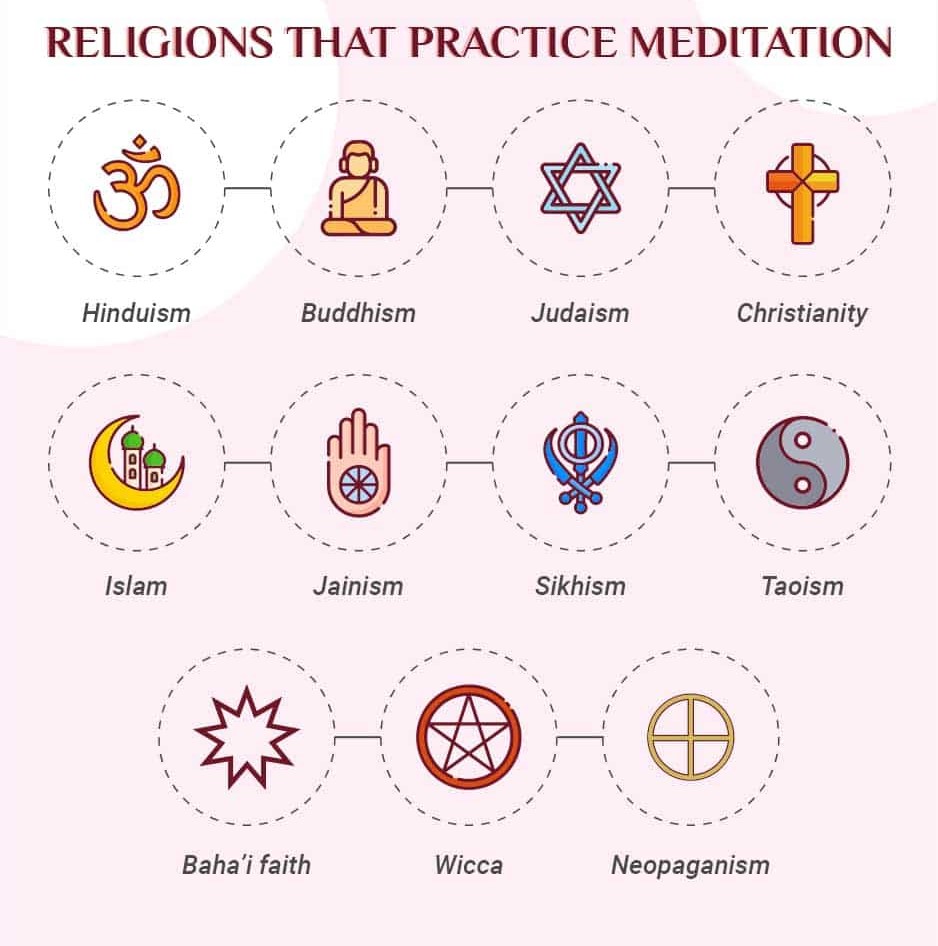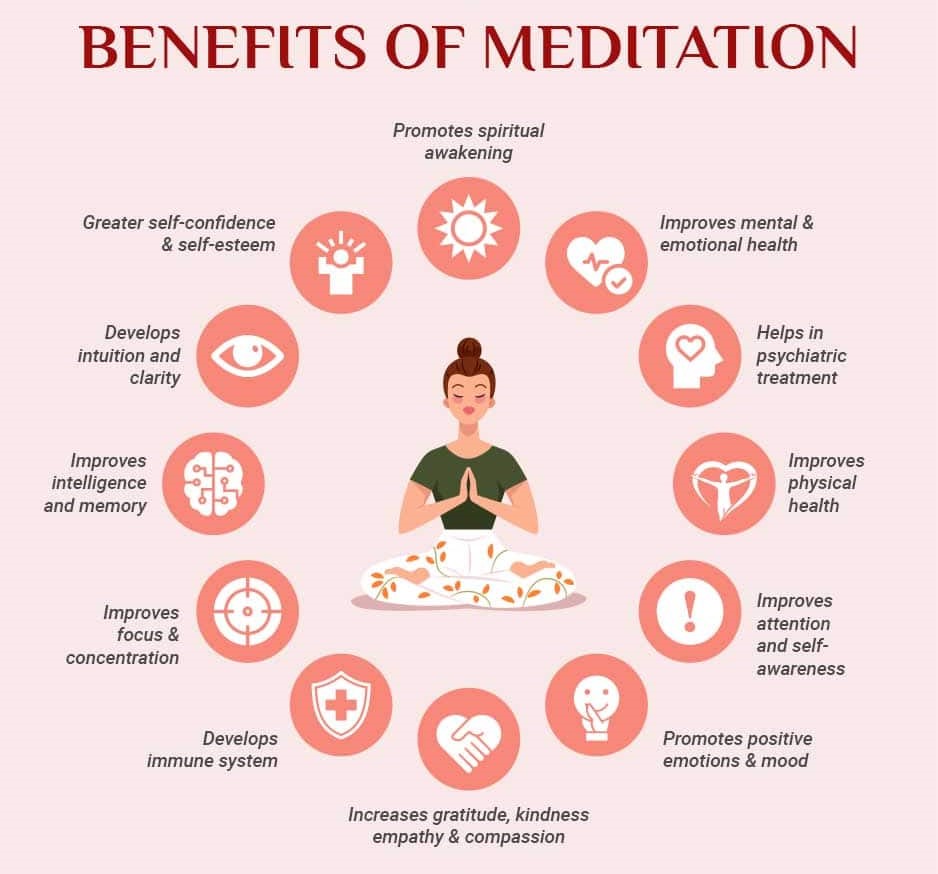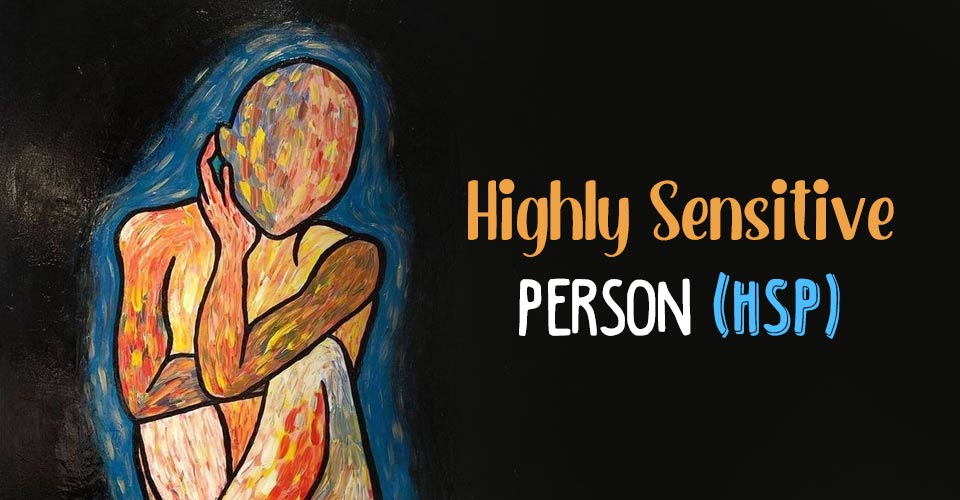Meditation is a practice that enables you to become aware of your thoughts, emotions, habits and surroundings. When practiced regularly, it can help to reduce stress and improve health.
What Is Meditation?
Meditation refers to a form of mental training practice that enables the practitioner to become aware of certain mental processes, improve focus and experience relaxation. The essence of this practice is to acquire a state of thoughtless, mindful awareness. Mindfulness [mfn] Keng, S. L., Smoski, M. J., & Robins, C. J. (2011). Effects of mindfulness on psychological health: a review of empirical studies. Clinical psychology review, 31(6), 1041–1056. https://doi.org/10.1016/j.cpr.2011.04.006 )) enables us to bring our attention to the present moment and be aware of what we are doing & where we are, without allowing external factors to make us feel overwhelmed. Practicing meditation on a regular basis enables us to develop heightened awareness and become more mindful in life. One 2006 study [mfn] Deshmukh V. D. (2006). Neuroscience of meditation. TheScientificWorldJournal, 6, 2239–2253. https://doi.org/10.1100/tsw.2006.353 [/mfn] states that it is an art of being alert and calm in the present moment without struggling to change yourself. It is a process that trains our mind and body to –
- Gain increased awareness
- Regulate our thoughts and feelings
- Develop concentration
- Relieve worry and stress
- Improve mood
- Better sleeping habits
- Increase pain tolerance
- Build a positive outlook towards life
Typically, meditation is practiced, either independently or in a group setting, in a seated position, with closed eyes and deep, controlled breathing. Contrary to popular belief, it is not about controlling or turning off our thoughts and feelings. It is simply about observing them in a non-judgemental way without reacting to or getting attached to them.
According to a 2019 study [mfn] Matko, K., & Sedlmeier, P. (2019). What Is Meditation? Proposing an Empirically Derived Classification System. Frontiers in psychology, 10, 2276. https://doi.org/10.3389/fpsyg.2019.02276 [/mfn] , meditation is considered as an umbrella term including an array of diverse practices. It is “a family of self-regulation practices that focus on training attention and awareness to bring mental processes under greater voluntary control and thereby foster general mental well-being and development and/or specific capacities such as calm, clarity, and concentration,” explains the study.
It is a contemplative, multi-generational practice that empowers the practitioner to focus on a single thought, idea, sound, experience or object with the objective of gaining better psychological well-being, improved existential insight and greater spiritual awareness. According to a 2014 study [mfn] Goyal, M., Singh, S., Sibinga, E. M., Gould, N. F., Rowland-Seymour, A., Sharma, R., Berger, Z., Sleicher, D., Maron, D. D., Shihab, H. M., Ranasinghe, P. D., Linn, S., Saha, S., Bass, E. B., & Haythornthwaite, J. A. (2014). Meditation programs for psychological stress and well-being: a systematic review and meta-analysis. JAMA internal medicine, 174(3), 357–368. https://doi.org/10.1001/jamainternmed.2013.13018 [/mfn] , “Meditative techniques are categorized as emphasizing mindfulness, concentration, and automatic self-transcendence.” The study adds that it can help to reduce psychological stress and have proved to improve anxiety, depression, and chronic pain. This spiritual and psychological practice can also improve health-related quality of life, claims the study.
Aspects Of Meditation
Studies [mfn] Jaseja H. (2009). Definition of meditation: Seeking a consensus. Medical hypotheses, 72(4), 483. https://doi.org/10.1016/j.mehy.2008.11.015 [/mfn] have observed that this mind and body technique is a “complex neural practice” that can alter the brain’s neurochemistry and neurophysiology leading to changed neurocognitive functions [mfn]Lardone, A., Liparoti, M., Sorrentino, P., Rucco, R., Jacini, F., Polverino, A., Minino, R., Pesoli, M., Baselice, F., Sorriso, A., Ferraioli, G., Sorrentino, G., & Mandolesi, L. (2018). Mindfulness Meditation Is Related to Long-Lasting Changes in Hippocampal Functional Topology during Resting State: A Magnetoencephalography Study. Neural plasticity, 2018, 5340717. https://doi.org/10.1155/2018/5340717 [/mfn] & behavior. Hence, in the long run, meditation can change the way we think and behave by promoting positive emotions and mood. According to research, this practice mainly involves three primary criteria –
- The use of a defined technique
- Logic relaxation (not judging, analyzing or expecting)
- A self-induced mode or state
The researchers observed that meditation may also involve the following aspects –
- A state of psycho-physical relaxation in the process
- The use of a self-focus skill or anchor
- The presence of an altered state of consciousness, enlightenment or a state of suspension of logical thought processes
- A religious, spiritual and philosophical context
- An experience of mental silence
Apart from these, the practice and art of meditation mainly focuses the following three mental elements –
1. Awareness
It strengthens our awareness and enables us to be more mindful by keeping our attention in the present moment, without getting attached to anything or distracted by something.
2. Focus
Concentration is another crucial aspect of this practice. It helps to direct our attention towards a specific idea, experience or object, whether external or internal.
3. Observation
It allows us to observe internal and external experiences without judging or getting involved in them. It helps us observe the present moment as it unfolds without getting distracted by or attached to a specific thing.
Some additional characteristics of this mind-body technique may include the following –
- Even when practiced in a group setting, meditation is an individual experience and practice
- Closing your eyes while practicing is a helpful habit but it is not always necessary as there are different open eye techniques as well
- It requires the practitioner to be physically and mentally still & calm. However, certain techniques may require body movement activities that promote mindfulness.
Understanding Meditation
It is a 2,500 year old mental practice that has been prevalent in different religions and cultures, such as Hinduism, Buddhism, Jainism, Christianity, Islam, Judaism etc. It is a consciousness-changing technique which trains the mind to become more alert and aware so that we can connect better with our inner self. Meditation is about observing your thoughts and feelings, not about blocking them out.
During the practice, the practitioner simply becomes aware of the thoughts that arise, acknowledges them and allows them to pass without getting involved or attached. When someone meditates, their mind is focused inwards as it calms and relaxes. Although initially some internal chatter may be present, with practice one can learn to control their internal distractions and enjoy a deeper, more focused meditative experience.
Although it is widely seen as a religious or spiritual practice, meditation can be practiced for individual reasons, such as to promote positive moods and emotions, reduce stress and anxiety, relaxation, better sleeping habits or overall better physical, emotional and mental wellbeing [mfn] Keng, S. L., Smoski, M. J., & Robins, C. J. (2011). Effects of mindfulness on psychological health: a review of empirical studies. Clinical psychology review, 31(6), 1041–1056. https://doi.org/10.1016/j.cpr.2011.04.006 [/mfn] . In fact, it is also used as a therapy technique [mfn] Bogart G. (1991). The use of meditation in psychotherapy: a review of the literature. American journal of psychotherapy, 45(3), 383–412. https://doi.org/10.1176/appi.psychotherapy.1991.45.3.383 [/mfn] to relieve symptoms of different mental health conditions. “Meditation may promote the diminishment of psychiatric illness, character change, and the resolution of neurosis,” adds a 2008 study [mfn] McGee M. (2008). Meditation and psychiatry. Psychiatry (Edgmont (Pa. : Township[/mfn], 5(1), 28–41. [/mfn] .
Another 2015 study [mfn] Sharma H. (2015). Meditation: Process and effects. Ayu, 36(3), 233–237. https://doi.org/10.4103/0974-8520.182756 [/mfn] explains that the word meditation is used loosely in the modern era, especially since it became popular in different Western nations, such as the United States. However, it basically refers to a wide array of diverse techniques, such as –
- Contemplation
- Concentration
- Listening to nature sounds such as rain or the ocean
- Guided meditation
- Meditative movement exercises like Yoga, tai chi & qigong
- Breathing exercises
- Mantra
“These techniques work at different levels such as the senses, mind, intellect, and emotions,” adds the study.
Meditation In Religion

Several religious and spiritual practices involve meditation as a core element. Although most religions [mfn] Montero-Marin, J., Perez-Yus, M. C., Cebolla, A., Soler, J., Demarzo, M., & Garcia-Campayo, J. (2019). Religiosity and Meditation Practice: Exploring Their Explanatory Power on Psychological Adjustment. Frontiers in psychology, 10, 630. https://doi.org/10.3389/fpsyg.2019.00630 [/mfn] mainly include similar crucial meditational tenets and practices, each follow their own distinct objectives, teachings, practices, legends and symbols. Here are some of the major religions that practice different forms of this mental, physical and spiritual practice –
1. Hinduism
Vedic Hinduism is closely associated with meditative practices and it has been mentioned in several ancient Hindu texts such as the Upanishads and the Bhagavad Gita. Dhyana [mfn] Srinivasan T. M. (2013). From meditation to dhyana. International journal of yoga, 6(1), 1–3. https://doi.org/10.4103/0973-6131.105934 [/mfn] is a form of Yoga practice that leads to “a state of abiding calm.” Moreover, various Hindu beliefs like Samadhi and Moksha are associated with this practice. According to a 2018 study [mfn] Vago, D. R., & Zeidan, F. (2016). The brain on silent: mind wandering, mindful awareness, and states of mental tranquility. Annals of the New York Academy of Sciences, 1373(1), 96–113. https://doi.org/10.1111/nyas.13171 [/mfn] , “Meditative concentration is sometimes referred to as ‘one-pointedness’ (Sanskrit: samādhi).”
2. Buddhism
Mediation forms one of the core aspects of the Noble Eightfold Path as laid down by Siddhartha Gautama or the Buddha. “The noble eightfold path and its focus on right mindfulness and right thinking are the corollary in Buddhist thought,” states a 2013 study [mfn] Aich T. K. (2013). Buddha philosophy and western psychology. Indian journal of psychiatry, 55(Suppl 2), S165–S170. https://doi.org/10.4103/0019-5545.105517 [/mfn] . In Buddhism, one can reach enlightenment through this spiritual practice.
4. Judaism
This religion is also closely associated with such practices. Jewish [mfn] Schenker J. G. (2008). The beginning of human life : status of embryo. Perspectives in Halakha (Jewish Religious Law). Journal of assisted reproduction and genetics, 25(6), 271–276. https://doi.org/10.1007/s10815-008-9221-6 [/mfn] meditation is primarily focused on calming the mind, gaining emotional insight, introspection, contemplation and visualization of mystical, ethical and philosophical ideas. In Judaism, this practice is believed to help practitioners gain better understanding of the Divine.
5. Christianity
Christianity involves various practices that can lead the practitioner into a meditative state. Although salvation can be achieved by Christians only through Christ, meditation can help one to connect with God and improve their spiritual worship. However, the meaning and purpose of this practice may be different in Christianity than in other Eastern religions. “Christian meditation focuses individuals on their personal salvation through Jesus Christ and the loving works of God,” explains a 2019 study [mfn] Kopel, J., & Habermas, G. R. (2019). Neural Buddhism and Christian mindfulness in medicine. Proceedings (Baylor University. Medical Center), 32(2), 308–310. https://doi.org/10.1080/08998280.2019.1581525 [/mfn] .
6. Islam
For muslims, the purpose of meditational practices is to remember God or Allah. Dhikr or “remembrance” refers to certain Islamic devotional acts where a practitioner repeats certain prayers and phrases. Murāqabah [mfn] Isgandarova N. (2019). Muraqaba as a Mindfulness-Based Therapy in Islamic Psychotherapy. Journal of religion and health, 58(4), 1146–1160. https://doi.org/10.1007/s10943-018-0695-y [/mfn] is a mind-body technique in Sufism, a spiritual tradition of Islam.
Apart from these, many other religions may involve meditative practices as a way to engage in spirituality and gain enlightenment –
- Jainism
- Sikhism
- Taoism
- Baha’i faith
- Wicca
- Neopaganism
Read More About Religion Here
Types Of Meditation
Meditation can be practiced in different forms, styles and types that enable us to gain increased awareness and inner peace. Here are some of the most common types of meditation –
1. Mindfulness meditation
This technique allows the practitioner to be fully present in the moment and observe their own thoughts without reacting to it. “Mindfulness can be defined as nonjudgmental attention to the present moment.” explains a 2019 study [mfn] Zhang, Q., Wang, Z., Wang, X., Liu, L., Zhang, J., & Zhou, R. (2019). The Effects of Different Stages of Mindfulness Meditation Training on Emotion Regulation. Frontiers in human neuroscience, 13, 208. https://doi.org/10.3389/fnhum.2019.00208 [/mfn] . It helps us to shift our focus away from thinking about the past or future and brings our attention to what we are experiencing now without any judgment. Mindfulness is an essential part of this practice and is present in almost all other forms. It can help to control negative emotions and improve memory & focus. Studies [mfn] Behan C. (2020). The benefits of meditation and mindfulness practices during times of crisis such as COVID-19. Irish journal of psychological medicine, 37(4), 256–258. https://doi.org/10.1017/ipm.2020.38 [/mfn] have found that mindfulness practices can be beneficial during times of crisis such as COVID-19.
2. Loving kindness meditation
Also known as Metta meditation, the primary objective of this technique is to develop an attitude of loving kindness towards others, including things that make us feel stressed. A 2015 study [mfn] Hofmann, S. G., Petrocchi, N., Steinberg, J., Lin, M., Arimitsu, K., Kind, S., Mendes, A., & Stangier, U. (2015). Loving-Kindness Meditation to Target Affect in Mood Disorders: A Proof-of-Concept Study. Evidence-based complementary and alternative medicine : eCAM, 2015, 269126. https://doi.org/10.1155/2015/269126 [/mfn] explains “Loving-kindness meditation (LKM) is a traditional meditation practice directly oriented toward enhancing unconditional and positive emotional states of kindness towards oneself and others.” A person can cultivate acceptance, love, compassion and kindness for themselves and others by chanting phrases with positive intentions, according to research [mfn] Kearney, D. J., Malte, C. A., McManus, C., Martinez, M. E., Felleman, B., & Simpson, T. L. (2013). Loving-kindness meditation for posttraumatic stress disorder: A pilot study. Journal of Traumatic Stress, 26(4), 426-434. https://doi.org/10.1002/jts.21832 [/mfn]. It can help to promote positive emotions [mfn] Zeng, X., Chiu, C. P., Wang, R., Oei, T. P., & Leung, F. Y. (2015). The effect of loving-kindness meditation on positive emotions: a meta-analytic review. Frontiers in psychology, 6, 1693. https://doi.org/10.3389/fpsyg.2015.01693 [/mfn] and reduce resentment, stress, anger, frustration etc.
3. Progressive relaxation
Also known as the body scan technique, this form requires that the practitioner to gradually mentally scan their body from their toes to the top of their head, especially in areas where they hold stress. The objective is to identify the stress in the body and release it to experience relaxation. The practitioner may be required to tense their muscles and then relax them to experience progressive relaxation. The goal of progressive relaxation is “to increase sensations of physical relaxation,” explains a 2010 study [mfn] Feldman, G., Greeson, J., & Senville, J. (2010). Differential effects of mindful breathing, progressive muscle relaxation, and loving-kindness meditation on decentering and negative reactions to repetitive thoughts. Behaviour research and therapy, 48(10), 1002–1011. https://doi.org/10.1016/j.brat.2010.06.006 [/mfn] .
4. Vipassana Meditation
Vipassana is an ancient [mfn] Chiesa A. (2010). Vipassana meditation: systematic review of current evidence. Journal of alternative and complementary medicine (New York, N.Y.), 16(1), 37–46. https://doi.org/10.1089/acm.2009.0362 [/mfn] meditative practice. It is a gentle, observation-based silent technique that focuses on self-exploration and understanding the connection between our mind and body. Vipassana means to observe things as they are. It is one of the most controlled forms of meditation as the practice is transferred from teacher to student, according to Buddhist principles. According to a 2001 study [mfn] Al-Hussaini, A., Dorvlo, A. S., Antony, S. X., Chavan, D., Dave, J., Purecha, V., Al-Rahbi, S., & Al-Adawi, S. (2001). Vipassana meditation:: A naturalistic, preliminary observation in Muscat. Journal for scientific research. Medical sciences, 3(2), 87–92. [/mfn] , it helps to control our tendency to dwell on the past, worry about the future, and lowers expectations, regrets & anxiety. It also helps the “participant to remain in the ‘here and now’ and achieve relative mental tranquillity.”
5. Zen Meditation
Also known as Zazen, this practice is mainly a Japanese Sōtō Zen Buddhist practice that is learned from a teacher as it includes multiple postures & steps. It is considered to be a form of open monitoring [mfn] Alda, M., Puebla-Guedea, M., Rodero, B., Demarzo, M., Montero-Marin, J., Roca, M., & Garcia-Campayo, J. (2016). Zen meditation, Length of Telomeres, and the Role of Experiential Avoidance and Compassion. Mindfulness, 7, 651–659. https://doi.org/10.1007/s12671-016-0500-5 [/mfn] meditation. It is typically practiced by sitting in a comfortable position, bringing your attention to your breath and being mindful about your thoughts. The word Zen [mfn] Hauswald, A., Übelacker, T., Leske, S., & Weisz, N. (2015). What it means to be Zen: marked modulations of local and interareal synchronization during open monitoring meditation. NeuroImage, 108, 265–273. https://doi.org/10.1016/j.neuroimage.2014.12.065 [/mfn] is derived from the Sanskrit term “dhyan” which means being in a meditative state. Studies [mfn] Lusnig, L., Radach, R., Mueller, C. J., & Hofmann, M. J. (2020). Zen meditation neutralizes emotional evaluation, but not implicit affective processing of words. PloS one, 15(2), e0229310. https://doi.org/10.1371/journal.pone.0229310 [/mfn] show that “Zen meditators showed larger openness to experience and less need for achievement and performance.”
6. Transcendental meditation
It is a spiritual technique that enables the practitioner to rise above or transcend their present state of being. This can result in increased mindfulness and spiritual experiences. The practice involves repeating certain phrases or mantras that are determined by the teacher based on different factors. It is similar to Vedic meditation. According to a 2008 study [mfn] Yunesian, M., Aslani, A., Vash, J. H., & Yazdi, A. B. (2008). Effects of Transcendental Meditation on mental health: a before-after study. Clinical practice and epidemiology in mental health : CP & EMH, 4, 25. https://doi.org/10.1186/1745-0179-4-25 [/mfn] , this technique helps the practitioner to experience relaxation and “may improve mental health of young adult population especially in the areas of somatisation and anxiety [mfn] Orme-Johnson, D. W., & Barnes, V. A. (2014). Effects of the transcendental meditation technique on trait anxiety: a meta-analysis of randomized controlled trials. Journal of alternative and complementary medicine (New York, N.Y.), 20(5), 330–341. https://doi.org/10.1089/acm.2013.0204 [/mfn] , and this effect seems to be independent of age, sex and marital status.”
9. Yoga
Yoga involves several meditative techniques that can improve both our mental and physical wellbeing. It is an ancient Indian practice that involves mental, physical and spiritual disciplines and is aimed at calming and controlling the mind. Kundalini yoga [mfn] Shannahoff-Khalsa D. S. (2004). An introduction to Kundalini yoga meditation techniques that are specific for the treatment of psychiatric disorders. Journal of alternative and complementary medicine (New York, N.Y.), 10(1), 91–101. https://doi.org/10.1089/107555304322849011 [/mfn] is a popular form of meditation that includes various techniques like deep breathing, body movements & postures, singing and chanting mantras repeatedly. It can help to reduce stress [mfn] García-Sesnich, J. N., Flores, M. G., Ríos, M. H., & Aravena, J. G. (2017). Longitudinal and Immediate Effect of Kundalini Yoga on Salivary Levels of Cortisol and Activity of Alpha-Amylase and Its Effect on Perceived Stress. International journal of yoga, 10(2), 73–80. https://doi.org/10.4103/ijoy.IJOY_45_16 [/mfn] , anxiety [mfn] Gabriel, M. G., Curtiss, J., Hofmann, S. G., & Khalsa, S. (2018). Kundalini Yoga for Generalized Anxiety Disorder: An Exploration of Treatment Efficacy and Possible Mechanisms. International journal of yoga therapy, 28(1), 97–105. https://doi.org/10.17761/2018-00003 [/mfn] , depression, cognitive decline [mfn] Eyre, H. A., Siddarth, P., Acevedo, B., Van Dyk, K., Paholpak, P., Ercoli, L., St. Cyr, N., Yang, H., Khalsa, D. S., & Lavretsky, H. (2017). A randomized controlled trial of Kundalini yoga in mild cognitive impairment. International Psychogeriatrics, 29(4), 557-567. https://doi.org/10.1017/s1041610216002155 [/mfn] , chronic pain and improve mental health. “The ancient system of Kundalini yoga includes a vast array of meditation techniques and many were discovered to be specific for treating the psychiatric disorders as we know them today,” explains a 2004 study [mfn] Shannahoff-Khalsa D. S. (2004). An introduction to Kundalini yoga meditation techniques that are specific for the treatment of psychiatric disorders. Journal of alternative and complementary medicine (New York, N.Y.), 10(1), 91–101. https://doi.org/10.1089/107555304322849011 [/mfn] .
9. Mantra meditation
Also referred to as Om meditation, this type of technique [mfn] Innes, K. E., Selfe, T. K., Kandati, S., Wen, S., & Huysmans, Z. (2018). Effects of Mantra Meditation versus Music Listening on Knee Pain, Function, and Related Outcomes in Older Adults with Knee Osteoarthritis: An Exploratory Randomized Clinical Trial (RCT). Evidence-based complementary and alternative medicine : eCAM, 2018, 7683897. https://doi.org/10.1155/2018/7683897 [/mfn] requires the practitioner to chant a word or syllable in a repeated manner with the intention of focusing their mind. However, it is not similar to reciting an affirmation to persuade oneself. Mantra is a Sanskrit term meaning a word that is chanted for spiritual purposes. It helps to focus the mind, boost concentration and improve mindfulness. The chosen mantra may not have any meaning or relevance. One 2018 study [mfn] Lynch, J., Prihodova, L., Dunne, P. J., O’Leary, C., Breen, R., Carroll, Á., Walsh, C., McMahon, G., & White, B. (2018). Mantra meditation programme for emergency department staff: a qualitative study. BMJ open, 8(9), e020685. https://doi.org/10.1136/bmjopen-2017-020685 [/mfn] found that this form of meditative practice can be considered as “a viable tool” for improving awareness, attention, emotion regulation, ability to cope with stress and better mental wellbeing [mfn] Lynch, J., Prihodova, L., Dunne, P. J., Carroll, Á., Walsh, C., McMahon, G., & White, B. (2018). Mantra meditation for mental health in the general population: A systematic review. European Journal of Integrative Medicine, 23, 101-108. https://doi.org/10.1016/j.eujim.2018.09.010 [/mfn]
.Apart from these, there are many other forms of meditative practices such as –
- Vedic Meditation
- Chakra Meditation
- Tantric Meditation
- Self-Enquiry Meditation
- Taoist Meditation
- Qigong Meditation
- Chakra Meditation
- Open monitoring meditation
- Focused attention meditation
- Spiritual Meditation
- Focused Meditation
- Movement Meditation
- Visualization
- Chanting Meditation
- Guided Meditation
How Meditation Affects Health
Regular meditation offers an array of psychological, physical and emotional health benefits. This habitual process not only helps to train our mind, heighten our awareness and help us relax, it can also enable us to better cope with daily stressors and different mental and physical illnesses. Some of the most prominent and proven health benefits of this mind & body practice and mentioned below –
1. Changes brain structure
Research [mfn] Lardone, A., Liparoti, M., Sorrentino, P., Rucco, R., Jacini, F., Polverino, A., Minino, R., Pesoli, M., Baselice, F., Sorriso, A., Ferraioli, G., Sorrentino, G., & Mandolesi, L. (2018). Mindfulness Meditation Is Related to Long-Lasting Changes in Hippocampal Functional Topology during Resting State: A Magnetoencephalography Study. Neural plasticity, 2018, 5340717. https://doi.org/10.1155/2018/5340717 [/mfn] has observed that meditation can help to change the structure of the brain in the long run. “Neuroimaging studies have shown that the brain connectivity changes in meditators,” add the researchers. This can help to improve cognitive functions and reduce age-related brain degeneration. Mindfulness practices also help to increase regional gray matter density [mfn] Hölzel, B. K., Carmody, J., Vangel, M., Congleton, C., Yerramsetti, S. M., Gard, T., & Lazar, S. W. (2011). Mindfulness practice leads to increases in regional brain gray matter density. Psychiatry research, 191(1), 36–43. https://doi.org/10.1016/j.pscychresns.2010.08.006 [/mfn] in the brain, which improves emotion regulation, perspective taking, self-referential processing, memory and learning. Another 2014 study [mfn] Singleton, O., Hölzel, B. K., Vangel, M., Brach, N., Carmody, J., & Lazar, S. W. (2014). Change in Brainstem Gray Matter Concentration Following a Mindfulness-Based Intervention is Correlated with Improvement in Psychological Well-Being. Frontiers in human neuroscience, 8, 33. https://doi.org/10.3389/fnhum.2014.00033 [/mfn] revealed that meditative practices changes brain regions that are associated with stress-related reactions & improves overall psychological well-being.
Further studies reveal that this practice is also related to differences in default mode network activity & functional connectivity, which are associated with mind-wandering and unhappiness.
2. Improves mental and emotional health
A growing body of evidence shows that this practice is closely associated with improved mental health. Studies [mfn] Goyal, M., Singh, S., Sibinga, E. M., Gould, N. F., Rowland-Seymour, A., Sharma, R., Berger, Z., Sleicher, D., Maron, D. D., Shihab, H. M., Ranasinghe, P. D., Linn, S., Saha, S., Bass, E. B., & Haythornthwaite, J. A. (2014). Meditation programs for psychological stress and well-being: a systematic review and meta-analysis. JAMA internal medicine, 174(3), 357–368. https://doi.org/10.1001/jamainternmed.2013.13018 [/mfn] have shown that people who meditate regularly experience lower levels of stress & stress-related health issues. Moreover, they are also better able to respond and react to stressful situations. However, it can also be used as a therapeutic tool to overcome psychiatric disorders, such as anxiety [mfn] Chen, K. W., Berger, C. C., Manheimer, E., Forde, D., Magidson, J., Dachman, L., & Lejuez, C. W. (2012). Meditative therapies for reducing anxiety: a systematic review and meta-analysis of randomized controlled trials. Depression and anxiety, 29(7), 545–562. https://doi.org/10.1002/da.21964 [/mfn] and depression [mfn] Jain, F. A., Walsh, R. N., Eisendrath, S. J., Christensen, S., & Rael Cahn, B. (2015). Critical analysis of the efficacy of meditation therapies for acute and subacute phase treatment of depressive disorders: a systematic review. Psychosomatics, 56(2), 140–152. https://doi.org/10.1016/j.psym.2014.10.007 [/mfn] .
One 2010 study [mfn] Hofmann, S. G., Sawyer, A. T., Witt, A. A., & Oh, D. (2010). The effect of mindfulness-based therapy on anxiety and depression: A meta-analytic review. Journal of consulting and clinical psychology, 78(2), 169–183. https://doi.org/10.1037/a0018555 [/mfn] has found that mindfulness-based therapy can significantly help in treating anxiety and mood problems, like depression. It has also been observed that even a single session can reduce anger [mfn] Fennell, A. B., Benau, E. M., & Atchley, R. A. (2016). A single session of meditation reduces of physiological indices of anger in both experienced and novice meditators. Consciousness and cognition, 40, 54–66. https://doi.org/10.1016/j.concog.2015.12.010 [/mfn] and fear in novice & experienced meditators. One 2016 study explains that brief mindfulness meditation “produces demonstrable changes in emotional processing indicative of reduced emotional reactivity.”
3. Helps in psychiatric therapy
According to a 2008 study [mfn] McGee M. (2008). Meditation and psychiatry. Psychiatry (Edgmont (Pa. : Township[/mfn], 5(1), 28–41. [/mfn] , meditation can be an effective psychotherapy tool [mfn] Shapiro, D. H., Jr, & Giber, D. (1978). Meditation and psychotherapeutic effects. Self-regulation strategy and altered state of consciousness. Archives of general psychiatry, 35(3), 294–302. https://doi.org/10.1001/archpsyc.1978.01770270044003 [/mfn] for coping with different mental conditions and adding value to the practice of psychiatry. Substantial literature suggests that meditation is beneficial for “a variety of psychiatric and medical conditions and for enhancing wellbeing and functioning,” adds the study. Hence, it can also prove to be “a helpful tool for promoting the healing of individuals who are mentally ill.”
Researchers believe that by demystifying the practice, therapists can use it as a formal practice of actions in psychotherapy. One 2016 study [mfn] Groves P. (2016). Mindfulness in psychiatry – where are we now?. BJPsych bulletin, 40(6), 289–292. https://doi.org/10.1192/pb.bp.115.052993 [/mfn] states that mindfulness practices can be considered as an alternative treatment approach. It can not only complement other strategies but can also prove to be an effective treatment in its own right. “Mindfulness may increase the range of treatment choices for patients,” adds the study.
Researchers [mfn] Kutz, I., Borysenko, J. Z., & Benson, H. (1985). Meditation and psychotherapy: a rationale for the integration of dynamic psychotherapy, the relaxation response, and mindfulness meditation. The American journal of psychiatry, 142(1), 1–8. https://doi.org/10.1176/ajp.142.1.1 [/mfn] further point out that this practice is an effective self-awareness technique that leads to positive cognitive and emotional changes which are regarded as therapeutic. “The relaxation and reduction of stress that are claimed to result from meditation may have prophylactic and therapeutic health benefits, and a plethora of research papers purport to show this,” explains a 2003 study [mfn] Canter P. H. (2003). The therapeutic effects of meditation. BMJ (Clinical research ed.), 326(7398), 1049–1050. https://doi.org/10.1136/bmj.326.7398.1049 [/mfn] . As a therapeutic practice it can help cope with anxiety, depression, PTSD [mfn] Gallegos, A. M., Crean, H. F., Pigeon, W. R., & Heffner, K. L. (2017). Meditation and yoga for posttraumatic stress disorder: A meta-analytic review of randomized controlled trials. Clinical psychology review, 58, 115–124. https://doi.org/10.1016/j.cpr.2017.10.004 [/mfn] (post-traumatic stress disorder), schizophrenia [mfn] Sheng, J. L., Yan, Y., Yang, X. H., Yuan, T. F., & Cui, D. H. (2019). The effects of Mindfulness Meditation on hallucination and delusion in severe schizophrenia patients with more than 20 years’ medical history. CNS neuroscience & therapeutics, 25(1), 147–150. https://doi.org/10.1111/cns.13067 [/mfn] , OCD [mfn] Hanstede, M., Gidron, Y., & Nyklícek, I. (2008). The effects of a mindfulness intervention on obsessive-compulsive symptoms in a non-clinical student population. The Journal of nervous and mental disease, 196(10), 776–779. https://doi.org/10.1097/NMD.0b013e31818786b8 [/mfn] (obsessive compulsive disorder), substance use disorders [mfn] Brewer, J. A., Bowen, S., Smith, J. T., Marlatt, G. A., & Potenza, M. N. (2010). Mindfulness-based treatments for co-occurring depression and substance use disorders: what can we learn from the brain?. Addiction (Abingdon, England), 105(10), 1698–1706. https://doi.org/10.1111/j.1360-0443.2009.02890.x [/mfn] and ADHD [mfn] Modesto-Lowe, V., Farahmand, P., Chaplin, M., & Sarro, L. (2015). Does mindfulness meditation improve attention in attention deficit hyperactivity disorder?. World journal of psychiatry, 5(4), 397–403. https://doi.org/10.5498/wjp.v5.i4.397 [/mfn] (attention deficit hyperactivity disorder).
4. Improves physical health
Health professionals have observed regular meditation practice can help in managing physical health problems and diseases. Studies [mfn] Hilton, L., Hempel, S., Ewing, B. A., Apaydin, E., Xenakis, L., Newberry, S., Colaiaco, B., Maher, A. R., Shanman, R. M., Sorbero, M. E., & Maglione, M. A. (2017). Mindfulness Meditation for Chronic Pain: Systematic Review and Meta-analysis. Annals of behavioral medicine : a publication of the Society of Behavioral Medicine, 51(2), 199–213. https://doi.org/10.1007/s12160-016-9844-2 [/mfn] show that mindfulness practice can help to reduce chronic pain and improve quality of life. It helps to increase our pain tolerance, transform the state of our mind and improves our ability to cope with the sensation of pain. Regular practice can reduce the impact and frequency of headaches, migraine, hypertensive conditions, psoriasis, osteoarthritis & other chronic pains. This practice can also help with sleep difficulties [mfn] Rusch, H. L., Rosario, M., Levison, L. M., Olivera, A., Livingston, W. S., Wu, T., & Gill, J. M. (2019). The effect of mindfulness meditation on sleep quality: a systematic review and meta-analysis of randomized controlled trials. Annals of the New York Academy of Sciences, 1445(1), 5–16. https://doi.org/10.1111/nyas.13996 [/mfn] , inflammatory bowel disease (IBD [mfn] Yeh, A. M., Wren, A., & Golianu, B. (2017). Mind–body interventions for pediatric inflammatory bowel disease. Children, 4(4), 22. https://doi.org/10.3390/children4040022 [/mfn] ), irritable bowel syndrome (IBS) etc.
Further studies [mfn] Bai, Z., Chang, J., Chen, C., Li, P., Yang, K., & Chi, I. (2015). Investigating the effect of transcendental meditation on blood pressure: a systematic review and meta-analysis. Journal of human hypertension, 29(11), 653–662. https://doi.org/10.1038/jhh.2015.6 [/mfn] reveal that it helps to manage and reduce high blood pressure and coronary heart disease [mfn] Koike, M. K., & Cardoso, R. (2014). Meditation can produce beneficial effects to prevent cardiovascular disease. Hormone molecular biology and clinical investigation, 18(3), 137–143. https://doi.org/10.1515/hmbci-2013-0056 [/mfn] , especially in older individuals. According to a 2013 study [mfn] Olex, S., Newberg, A., & Figueredo, V. M. (2013). Meditation: should a cardiologist care?. International journal of cardiology, 168(3), 1805–1810. https://doi.org/10.1016/j.ijcard.2013.06.086 [/mfn] , evidence suggests that meditation may decrease blood pressure acutely in the long run. The study adds that it can “positively influence the cardiovascular system,” and have “beneficial effects on patients with established cardiovascular disease.” Research [mfn] Carlson, L. E., Beattie, T. L., Giese‐Davis, J., Faris, P., Tamagawa, R., Fick, L. J., Degelman, E. S., & Speca, M. (2014). Mindfulness‐based cancer recovery and supportive‐expressive therapy maintain telomere length relative to controls in distressed breast cancer survivors. Cancer, 121(3), 476-484. https://doi.org/10.1002/cncr.29063 [/mfn] also indicates that meditation is beneficial against cancer as it tends to alter cellular activity in cancer patients. Studies [mfn] Bower, J. E., Crosswell, A. D., Stanton, A. L., Crespi, C. M., Winston, D., Arevalo, J., Ma, J., Cole, S. W., & Ganz, P. A. (2015). Mindfulness meditation for younger breast cancer survivors: a randomized controlled trial. Cancer, 121(8), 1231–1240. https://doi.org/10.1002/cncr.29194 [/mfn] further show that this practice can even help cancer survivors overcome stress and behavioral symptoms associated with the disease.
Benefits Of Meditation

Regular meditation offers an array of benefits, apart from improving our physical, mental and emotional wellbeing. It is an excellent way to develop various positive and healthy habits, improve mood, strengthen relationships, build self-discipline, improve sleep and reduce pain. Here are some of the most commonly observed benefits of regular practice
- Improves attention and self-awareness
- Increases stress management abilities
- Enables one to live in the moment
- Improves creativity and imagination
- Enhances tolerance and patience
- Promotes positive emotions & mood
- Increases a sense of inner peace, calm, relaxation & balance
- Better emotional well-being
- Increases gratitude, kindness, forgiveness, empathy and compassion
- Improves intelligence and memory
- Develops immune system
- Improves focus & concentration
- Improves blood circulation & lowers respiratory rate
- Lower levels of blood cortisol
- Develops emotional regulation and stability
- Enhanced feelings of happiness and joy
- Develops intuition and clarity
- Supports personal transformation
- Greater self-confidence, self-esteem, mental strength and resilience
- Results in better skin
- Better eating habits and reduces food cravings & binge eating
- Promotes healthy formation of habits
- Improves romantic and interpersonal relationships
- Helps overcome addiction
- Reduces negative thoughts & emotions
- Prevents burnout
- Improves sex life
- Promotes spiritual awakening
- Helps cope with trauma, loneliness and depression
- Helps build a sense of purpose
However, to experience such benefits one needs to practice regularly and learn to reach a meditative state. One can start experiencing the beneficial outcomes by simply meditating for around 10 minutes daily. It allows us to pause from our daily life and take a deeper look into ourselves.
How To Meditate

Starting to meditate may seem like a complicated and daunting task for a beginner, but once you understand that the core essence of the practice is awareness, you can start practicing easily anywhere, anytime. As there are different forms of meditation, you can explore the types and choose the one that is most appropriate for you. However, mindfulness meditation is perhaps the most simplest, effective and most recommended form for beginners. But before we delve into how one can start their practice, here are a few elements a new practitioner should know about –
- Focused attention is the primary aspect of this practice
- Deep, evenly paced, diaphragmatic breathing is a basic technique
- Must be practiced in a quiet setting with minimal or no distractions
- Must be in a comfortable position, whether sitting, walking or lying down
- Having an open mind is crucial to let thoughts pass without reacting
In order to practice, one does not need to be religious or spiritual or prevent any thoughts from appearing. All you need to do is focus your attention on your breath and be mindful of the present moment. Here are the steps to start meditating –
1. Choose a quiet place
Select a space which is calm, quiet and distraction free. It can be your bedroom, your garden, or somewhere out in nature as long as no one will disturb your practice. However, make sure that the place is safe for you to meditate.
2. Be comfortable
You can choose to sit or lie in a comfortable position while you meditate. You can sit on a chair, on the bed, a cushion, a mat or on the floor as long as you feel comfortable. Relax your body and sit up straight without tensing up any specific body part.
3. Close your eyes
Gently close your eyes without forcing them to close or exerting any pressure to keep them closed. Be relaxed and let it happen naturally.
4. Breathe deeply, yet gently
Take a few deep breaths and slowly let your breath follow its natural pace. Do not attempt to control your breathing. Breathe in a natural way and focus your attention on the middle point between inhaling and exhaling. Make sure to breathe from your stomach for deeper breaths.
5. Body scan
An alternative to deep breathing is the body scan method. Simply focus on a specific body part and observe the sensations carefully. You can start from your toes and gradually move towards your head.
6. Don’t get attached to internal chatter
As you meditate, your mind will wander and several different thoughts, memories and emotions will surface. Instead of being distracted by them or trying to avoid them, simply acknowledge them in a non-judgmental way and let them pass. Keep your focus on your breath and avoid dwelling on the distractions. Remember our internal chatter is a natural phenomenon and learning to manage them is an important part of being mindful.
7. Carry the positive emotions
Once you are done with your meditation practice, bring your awareness back to your reality while feeling the peace of mind, clarity, calmness and positive emotions. Carry these feelings with you as you continue your day and go through your daily life.
8. Have an open mind
You should also remember that every session may feel different from the previous one and it is natural for you to feel like that. Do not be overwhelmed by different emotions. There is no right or wrong way to meditate as long you keep your attention and awareness on your breath. Just keep practicing on a regular basis.
How Long Should You Meditate
You can start your practice by meditating for 2 minutes every day and eventually increase the duration to 5 to 10 minutes each day. As you get better with your practice, you can choose to meditate for as long as 30-45 minutes. However, you can enjoy the benefits with a regular, brief [mfn] Moore, A., Gruber, T., Derose, J., & Malinowski, P. (2012). Regular, brief mindfulness meditation practice improves electrophysiological markers of attentional control. Frontiers in human neuroscience, 6, 18. https://doi.org/10.3389/fnhum.2012.00018 [/mfn] mindfulness practice as well. It is important that you try to meditate at the same time every day in order to make it a habitual practice. In case you miss out on a session, don’t feel too overwhelmed as you can continue your routine from the next day.
If you find meditating by yourself to be a challenging process, then you may try out group meditation or seek help from a certified professional or instructor in your community. You can also try out guided meditation by referring to guided audio or video sessions online or try a reliable app to start meditating. You may also read some books on the topic or do some research online to gain additional information about the process.
Takeaway
Meditation is a simple mind-body practice that everyone and anyone can practice to experience better mental & physical health and spiritual enlightenment. Although it may take some time for you to perfect the practice, you will start experiencing the benefits almost instantaneously. According to a 2018 study [mfn] Norris, C. J., Creem, D., Hendler, R., & Kober, H. (2018). Brief Mindfulness Meditation Improves Attention in Novices: Evidence From ERPs and Moderation by Neuroticism. Frontiers in human neuroscience, 12, 315. https://doi.org/10.3389/fnhum.2018.00315 [/mfn] , “individuals who are merely initiating a meditation practice may reap benefits after a single brief session.” Simply find out what type is best suited for your needs and keep practicing regularly and habitually. You can do it without having any specific equipment and practice anywhere to build a better life for yourself.
Meditation At A Glance
- Meditation is a contemplative mental training practice that makes us aware of our thoughts and emotions, helps to reduce stress, improve psychological wellbeing & experience spiritual awareness.
- The essence of this practice is to acquire a state of thoughtless, mindful awareness. It is about observing your thoughts and feelings, not about blocking them out.
- As it is mainly regarded as a spiritual practice, several religions involve meditation as a core element.
- There are different types and styles of meditation that a practitioner can choose from to gain increased awareness and inner peace.
- Research shows that regular meditation offers an array of psychological, physical and emotional health benefits. It also helps to develop healthy habits, improve mood, build self-discipline etc.
- To start meditating, one simply needs to focus their attention on their breath and be mindful of the present moment.











Leave a Reply